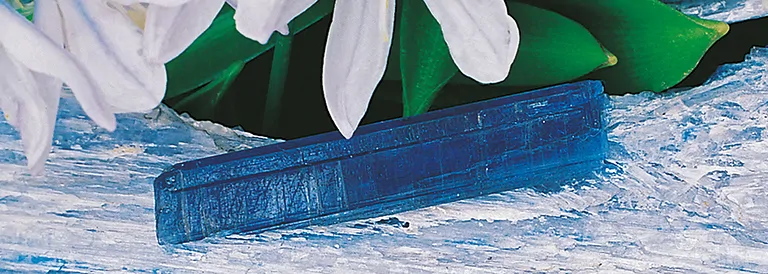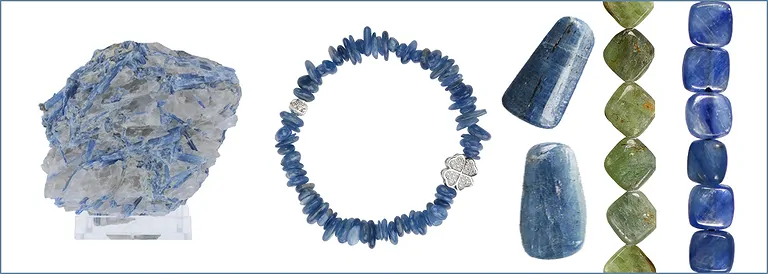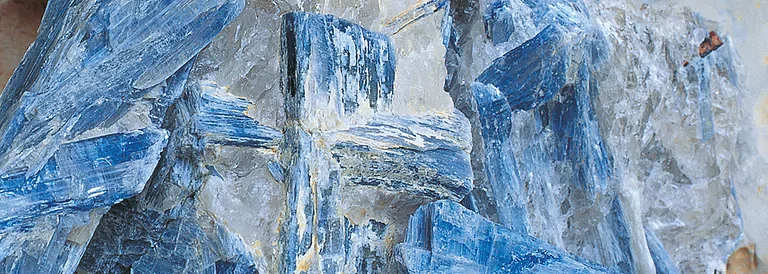
Kyanite / Disthene - Meaning, effect and applications
In energetic, sometimes hectic time helps the disthen to soberly and after careful consideration to choose the right path and then to continue this determined. With its support we can recognize which things in our life are based in ourselves and which factors we do not have ourselves in the hand. So we can stay completely with ourselves, feel our own identity and self-determined work on the further realization of our plans.
Disthene is also used in gemstone healing to promote serenity and resolute strength . It dissolves victim attitudes and belief in fate. Worn as a gemstone necklace or bracelet, disthene can therefore be a good companion during difficult periods in life due to its effects.
Massage stones made of disthene with Ruby are used in gemstone wellness when support is needed in the completion of life's task and in extreme situations the ability to act should be preserved. Rods together with fuchsite and ruby strengthen integrity and individuality and support to maintain self-reliance in strenuous situations.

Name Disthene - Kyanite
The name disthene comes from the Greek "dis" ("two") and "sthenos" ("strength"), thus means "twofold strength, twofold hardness". The mineral was named in 1801 by the French mineralogist René-Just Haüy, who refers to the electrical properties and the different scratch hardness in different directions. Kyanite, as the blue mineral is also still called and was designated by Abraham Gottlob Werner already in 1789, has the origin from the Greek "kyanos" ("blue") and describes the predominant color of the mineral. As spellings of the second name can also be found in the literature cyanite, zianite, kianite or cyanite.
Uncommon, rather older synonyms for the mineral are sappar, sapparite, sapphire spar, munkrudite, distenite, pseudo-andalusite, and rhaetite. "Kyanos" used to be the collective name for all blue minerals, thus also for Azurite or Lapis Lazuli; the mineral Disthene was defined as an independent mineral only in the 18th century. Traditions to the application and effect from the time before therefore do not exist.
Disthene develops tertiary with the metamorphosis of crystalline slates in more than 15 km depth at temperatures of more than 1500 degrees Celsius and is thus a characteristic leading mineral for a certain pressure-temperature relation in the appropriate rocks. Kyanite is usually accompanied by mica, garnet, quartz and rutile. Collectibles often show twinning and intergrowth. So far more than 1300 localities are known worldwide. Commercially available disthene comes mainly from Brazil, Russia and the USA. The majority of our articles from Disthene, which we have in the program, come from Brazil.
Mineralogical profile Kyanite
Chemical Formula: AI2[O/SiO4]
Mineral Class: Insular Silicate
Evolution: Metamorphic; characteristic mineral for crystalline schists
Color: sky blue, cornflower blue, blue-green, yellow-green, usually spotted color; rarely yellow, white or pink.
Small amounts of iron oxide Fe2O3 is responsible for the typical blue color most common in nature and thus predominant in commerce.
Gloss: vitreous luster, on cleavage surfaces also nacreous luster
Crystal system: triclinic
Moh hardness: Vertical, 4 to 4.5; transverse, 6 to 7
Splitability: perfect splitability; fibrous or brittle fracture
Occurrence, main supplying countries: Brazil, Western Australia, India, Kenya and Russia
Appearance: long, columnar crystals, radiating, fibrous, foliated aggregates

Use of Kyanite
Kyanite is used as a basis for the production of porcelain and highly refractory products.
In astrology, disthene combines the spontaneity of Aries-born with a clear spiritual orientation.
Chakra assignment: Brow chakra